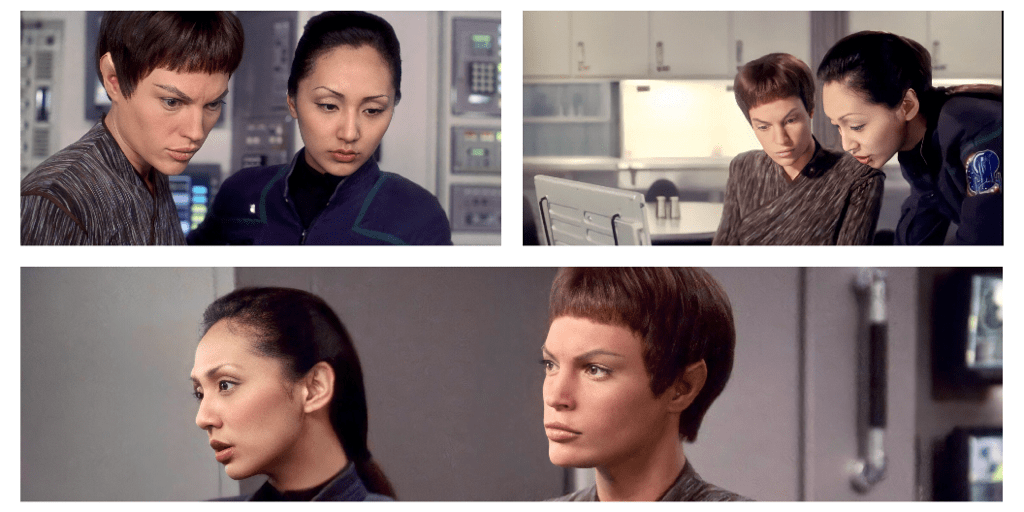
The Leading Ladies of Star Trek: Enterprise: Subcommander T’Pol (Jolene Blalock) and Ensign Hoshi Sato (Linda Park)
Strength is an abstract concept. It has neither innate masculine or feminine qualities and cannot be exclusively associated with one gender or another. However, we must recognize from a Western-Eurocentric perspective – which most of our popular culture comes from – there are biases based in patriarchy and heteronormativity which place gender-colored lenses on these concepts. Many, if not all, of the women characters we associate with empowerment in media exemplify stereotypically masculine concepts of strength.
In the context of Star Trek, a franchise well known for being forward thinking, we have been blessed with many strong, empowered woman characters; Captain Janeway, Major Kira, and Michael Burnham to name a few. However, the women who never seem to make this list are the leading ladies of Star Trek Enterprise (ENT). This seems to be based on a shallow assumption that women who do not perform a more masculine type of empowerment are in fact not empowered. This a sexist falsehood created by patriarchally defined concepts of human perseverance and power that have infected our view of the ENT women.
For this article we would like to highlight that strength comes in many forms. We, as women feel immensely empowered by the women of Star Trek: Enterprise, who are often overlooked. While some criticism is certainly valid, we must also examine the ways in which the women of ENT show strength, agency and empowerment. The women of ENT open a doorway in Trek, popular culture and feminist ideology to various ways in which women can, and must, continue to take up space, define their own strength, on their own terms.
Warning: Hot takes ahead.
T’Pol: Silence is Power
One way of measuring agency is through voice. Women who are outspoken and use their voice to occupy space are generally considered more empowered as they mirror the ways in which men are socially encouraged. Women’s silence is associated with submission, traditionally with how women ‘should’ behave in a patriarchal society. It’s seen as being weak and passive, traditionally assigned feminine traits within patriarchy.
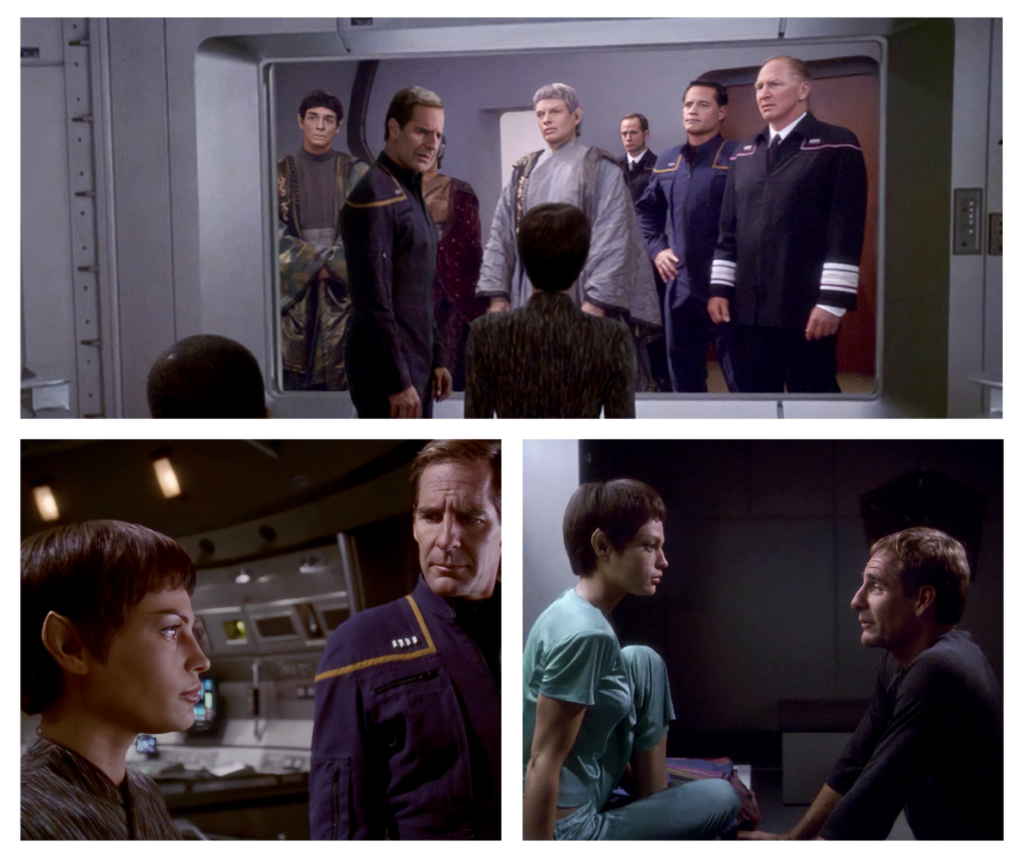
Scenes from “Shockwave, Part II”
This creates an unfair assumption that women who aren’t outspoken are being repressed in some way, when women being forced to use their voice are under the same control as women forced into silence. The power of women’s voices is not simply in their volume, but in the weight they carry. This is perfectly exemplified by T’Pol, who demonstrates her own individual strength through a few carefully chosen words and silences.
For instance in “Shockwave Part II,” the Vulcan High Command suggests terminating Enterprise’s mission after Starfleet’s first year in space. T’Pol makes a brief but poignant speech on behalf of Archer and Starfleet that shuts up Vulcan Ambassador Soval, after all the other men in the room had been arguing and debating. Archer thanks her later, on his knees, and says she put it “over the top.” You don’t have to be the loudest voice in the room for your words to carry the most weight.
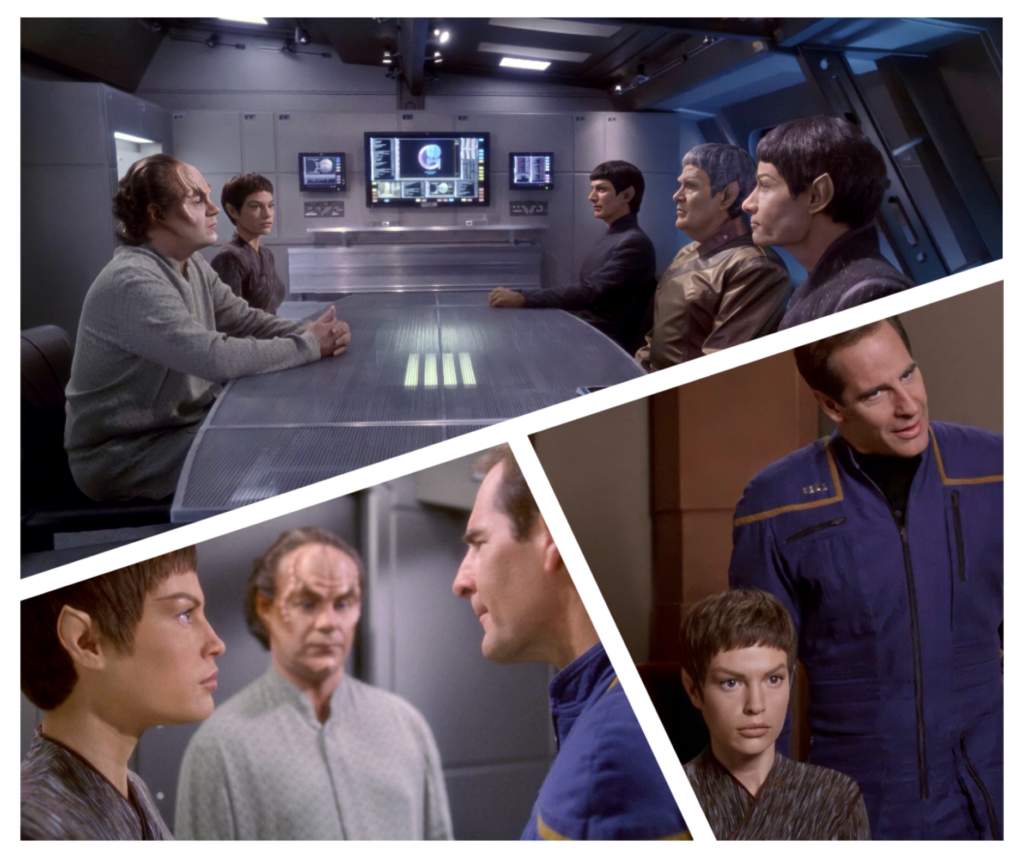
Scenes from “Stigma”
Silence as a form of power is most clearly illustrated in the Season 2 episode “Stigma.” T’Pol uses silence to do what she believes is morally right and never wavers from her convictions despite external pressures. T’Pol comes under investigation following the revelation she has contracted Pa’nar Syndrome from a non-consensual mind-meld. Women at Warp does an excellent job explaining the nuances of the titular stigma and how it is used as a metaphor for the AIDS crisis. Following a completely inappropriate interrogation of T’Pol and Phlox by Vulcan physicians, her career and health are held in men’s hands.
Archer aggressively resists the Vulcan physicians’ orders for T’Pol to return to Vulcan and organizes an inquest to settle the matter. However, T’Pol clearly communicates that she does not want to discuss her medical history nor the circumstances under which she contracted the disease. Some view this as Archer speaking over T’Pol rather than advocating on her behalf. Moreover as a survivor of assault, T’Pol doesn’t owe anyone an explanation of her story. These are very important points; however, we also need to consider that she is the only woman in the room in every shot of this episode and her character is placed in extremely difficult situations, and still she holds fast to her beliefs and own moral code.
After both Archer and Phlox pressure her to tell the Vulcan physicians that she contracted Pa’nar Syndrome through an unconsensual meld, T’Pol refutes, “If I use that as a defense, as a way to keep from being taken off Enterprise, I’d be condoning their prejudice and, in the process, indicting every member of the minority. I won’t do that.”
Archer believes at first that her silence signals her surrender, that she is submitting to prejudice and is accepting her forced removal from her position by a group of male doctors. As viewers, we may also come to the same conclusion that she is just a victim of assault and now a stigma that will ruin her life. However, T’Pol repeatedly states throughout the episode that she is electing to stay silent because she doesn’t want to become complicit in the societal violence against this minority. So really her silence is her way of realizing her agency in a situation where, as Archer sees it, she doesn’t have a choice. But she does.
Although in the end, tragically and problematically, a member of the mind-melding minority that she is trying to protect outs himself as a melder and then exposes the nonconsensual circumstances of T’Pol’s meld. Even after her choice to keep the secret is taken, she still remains silent. It is then that Archer finally realizes what she is trying to do and how strongly she feels. When the Vulcan inquisitors demand Archer explain these circumstances, he simply states “Seems my Science Officer doesn’t want to discuss it. That’s good enough for me” Finally he gets it. (That’s the good male ally we remember him being in “Fusion.”)
T’Pol refuses to be defined by her trauma and remains proactive in her defiance of this injustice in Vulcan society. She does not need defending or protecting; she effectively makes her point by refusing to speak out. She’s constantly being reminded of her assault by men who are telling her what to do, so it shows the strength of her character that she still stays true to her own moral convictions. She’s an unmovable pillar, with men constantly trying to knock her down and/or chip away at her by criticizing her every decision.
Hoshi Sato: Owning Fear
The categorization of different forms of strength and bravery into gendered binaries under a patriarchal lens immediately pushes anything that fits our socially constructed idea of femininity into the same category as weakness unless exhibited by a cis man. When women exhibit traditionally feminine traits like voicing their fears, then it is seen as a weakness. Whereas when men exhibit the same traditionally feminine qualities then they are uplifted for having the courage to acknowledge their fears: men are made stronger by exposing their vulnerabilities whereas women are resigning themselves to remaining weak and powerless.
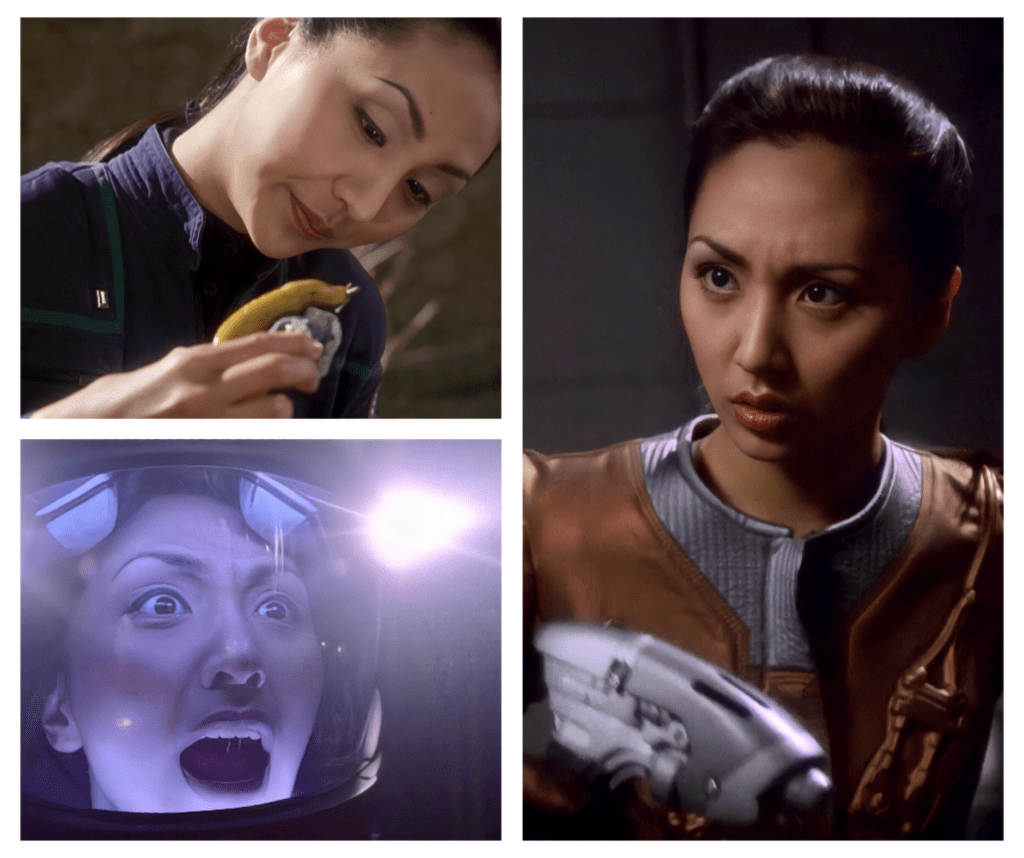
Scenes from “Fight or Flight”
This hypocritical micro-sexism is apparent when looking into Ensign Hoshi Sato’s reception as a woman character who expresses her fears and trepidation in contrast to the love given to men characters like Lt. Barclay and Captain Saru, whose character arcs are actually very similar. Hoshi is often criticized for being too naive, weak and whiny. Overall, in the fandom her character is predominantly described as being underdeveloped. While we agree the creators could have done her greater justice and given her more to do, Hoshi is still a main character that is fleshed out over the course of Enterprise’s four seasons. Moreover, she demonstrates a similar form of internal strength and propensity for perseverance. Hoshi voices her anxieties, but always perseveres (usually on her own) and goes above and beyond to complete her duty and save the ship and Earth.
In the series second episode, “Fight or Flight,” Hoshi Sato is characterized as a trepidant explorer via an obvious, if strange, metaphor of a space slug struggling to survive outside its natural habitat. Sato comments on nearly every strange sound the ship makes, declares her claustrophobia when asked to put on an EV suit and screams like a “twelve-year-old girl” during the away mission. At first glance this is a shallow and unflattering depiction of one of the only two women characters. However, upon closer inspection and through a generous feminist lens, Hoshi is not presented as less than for expressing fear. Instead, she is powerful because she overcomes every challenge put before her despite her reservations and learns from each experience.
When Doctor Phlox suggests Sato would be more comfortable as a professor back on Earth, Hoshi pushes back, affirming, “I’m an exolinguist. I graduated second in my class, I spent three years in Starfleet training, I was Johnathan Archer’s first choice for this mission. Every inhabited world we come to is going to be filled with language. Some will have hundreds of them. He needs me here.” Though she has her moments of doubt, Hoshi remains confident in her professional competency, works through and with her anxieties and bravely trail-blazes a path into the final frontier along with the rest of the crew.
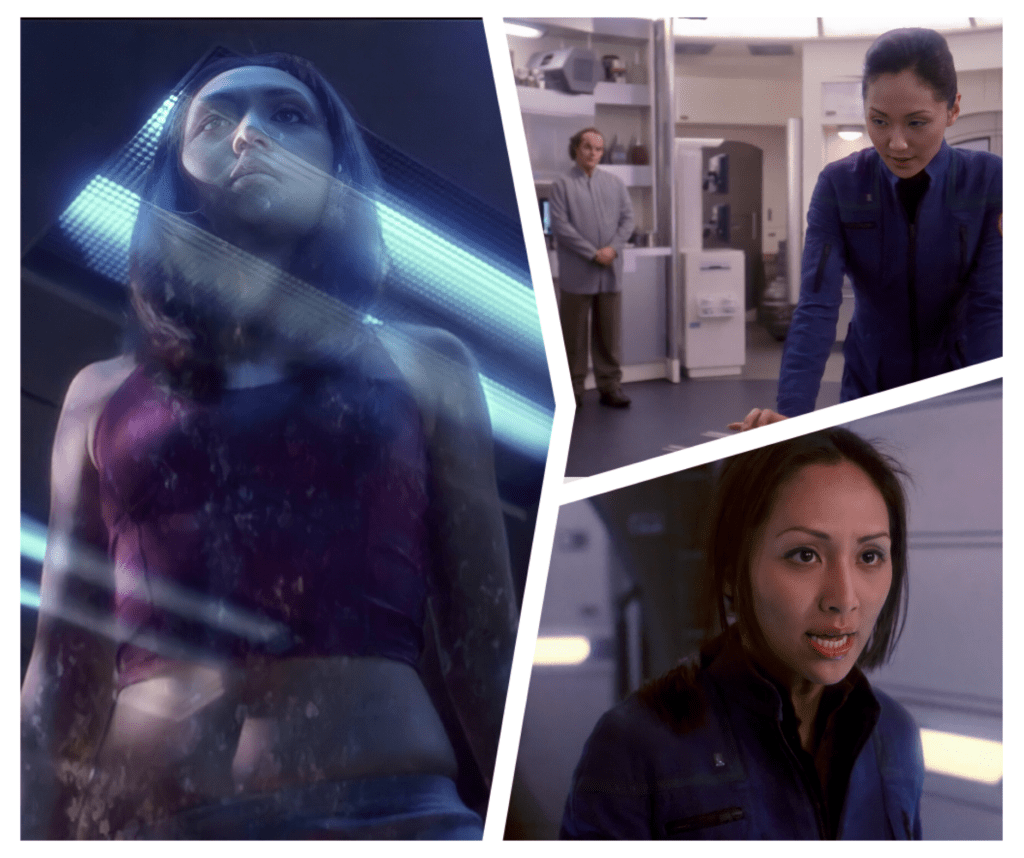
Scenes from “Vanishing Point”
During one of the other few Hoshi centered episodes, “Vanishing Point,” Ensign Sato proves her grit. Hoshi emergency transports to the ship for the first time and correctly insists that something is “not right.” Though she expresses her concern to Doctor Phlox and other members of the crew, she is told she is probably just frightened by the circumstances of the transport. Spoiler alert: Hoshi was correct, her molecules were pulling themselves apart, but not before she tried to valiantly save the Enterprise single handedly. The whole plot ends up being a kind of dream-like scenario in her head while she is stuck in the transporter’s pattern buffer (lame). Especially for Hoshi, it is extremely obvious in the writing and plot that she is a character created by men and their impression of what a fearful woman is like, it’s a further testament to Hoshi as a character and Linda Park that we can still see her push back against this sexism, even expressing the condescension and disbelief many women face. Regardless, Hoshi keeps her wits about her during an objectively horrifying situation and places the needs of her crew before herself.
From this perspective, Hoshi saving the day is actually a recurring theme. In the aforementioned episode “Shockwave II,” Hoshi plays an important role in taking back the Enterprise by crawling through vents, having to face her claustrophobia. Much later in the final season, Hoshi is key to saving Earth because she resists the Xindi under torture long enough to prevent them from attacking. Again and again, Hoshi proves that one can experience fear and anxiety but still be the toughest and bravest with the best of them.
By gendering types of strength and applying them to the gender of her character, we have forced Hoshi into the patriarchally-dictated idea that femininity equates to weakness, a locked box that remains open to male characters who are elevated for exhibiting this fabricated, feminine-associated strength. Even if we were to openly recognize her courage and accomplishments, that wouldn’t be enough to fully comprehend the strength and bravery in Hoshi. Hoshi owns her fear. If the vulnerability of Saru and Barclay are worth elevating in addition to their strength, then Hoshi’s conquering of fear and sexism should be elevated tenfold. Admit it: the only reason it isn’t is because she is a woman.
Conclusion
There should be an acceptance of a plethora of ways women can be strong and exhibit strength. Even between the two of us, the writers, one of us identifies more with Kira, Seven and B’Elanna as a more outspoken, typical representation of empowered womanhood. The other one has identified more with T’Pol and Hoshi for most of her life. Recognizing that we identify with different characters and express our feminist selves differently, showed us there are multitude of ways of being empowered.
As feminists we should all be empowering each other, allowing for varying conceptions of strength, to empower women in a male-dominated society generally and/or in a television franchise specifically. Having Hoshi and/or T’Pol as your favorite characters does not make you a bad feminist; only viewing any media with without a critical eye would. It’s not fair to say that women who create their own strength and power with what they are given are disempowered. Being a bad feminist is deciding what makes another person feel powerful and dictating how they should define and/or realize their own strength.
Our obligation as feminists is to amplify the voices of other women and realize that there are many ways for women to realize their agency. It’s giving into the patriarchy to assume there is only one way to be empowered, only one form of strength. We are not trying to convert B’Elanna, Michael and Kira stans to exclusively Hoshi stans. The point is to argue that one can find the women of Enterprise to be just as empowering and feminist. We would just be depriving ourselves by rejecting them as strong women characters. Whether or not you personally identify and/or feel empowered by these women, they do exhibit their own unique forms of strength and it would make us poor feminists and Trekkies to ignore that diversity as a valid form of strength.